If you are new to sculpting or just starting out with paper clay, one of the biggest challenges to creating something lifelike is getting the proportions right. When I was starting out, I constantly struggled with symmetry, proportion and where to place details like eyes and ears.
Of course, if you are making abstract sculptures, you're already good to go!
Because Creative Paperclay (CP) bonds so well with paper and fabric, and because we need some kind of armature to build on with our clay, a whole world of possibilities is open to us. I'm talking about paper craft. There are literally thousands of free paper craft models available to download, print, cut out and glue together.
While I personally like making animals, you can use any kind of paper craft as the armature for your sculptures, from vehicles to houses to almost any object you can think of, but you don't have to stop there, you can also combine multiple paper craft into something wholly unique, like a beast that is half animal and half machine.
Two of the best websites I have found for downloading free paper craft are:
Papermau
and
Canon Creative Park
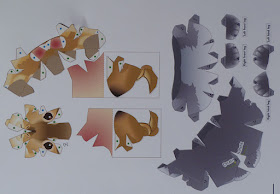 |
| Parts of paper craft models I used |
Paper crafters are a devoted group. Paper models can range from something simple, made from a single sheet of paper (these are usually not very detailed) to extremely complex pieces that can use hundreds of pieces cut from dozens of sheets of paper. After choosing a model or two, be sure to print them on card stock which will make for a firmer model.
I don't have a lot of patience when it comes to assembling paper models, so I look for ones that use as few pieces as possible, but still show lots of detail. Also, you usually don't have to use all of the pieces of a model. We really just want to establish the proper shape and proportion for an armature with guides to show us where to add the details.
I am even impatient enough that I don't like to glue all of the pieces, so I often just piece them together with little bits of masking tape. The model ends up looking horrid at this point, but it doesn't matter, because we are going to cover it with paper clay.
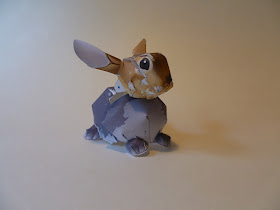 |
| Head and body assembled |
Another great part of using paper models for your armature is that once you have assembled the body, head and any other interesting parts, you can then decide where to position them in whatever pose you want to make. In other words, you are not tied to just mimicking the original paper craft.
This is a useful method for trying out different sculpture ideas without investing a lot of time or money.
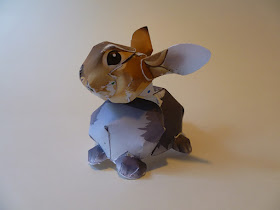 |
| Armature shows where to place details |
Once you have your paper armature put together and in a pose that you like, coat the entire surface (inside and out, if possible) with Paverpol, wood glue, or PVA (white, craft) glue and let it dry. This will firm up the card stock so you can use a little pressure when you are adding on the paper clay.
The next step is to add a thin layer of paper clay to your armature. One of the problems with paper craft models is that in cutting and folding flat pieces of paper, you end up with angles and pointy bits where they don't belong. When adding this first layer of paper clay, you can smooth out those angles.
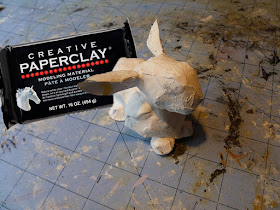 |
| Use CP to cover armature and smooth out curves |
Even though I might make some details stick out from the first layer of CP, when I add the final layer, I can adjust the proportions. The goal at this point is to keep clear the position where everything belongs.
We will be adding a second layer to put in the details and textures in the second part of this tutorial.
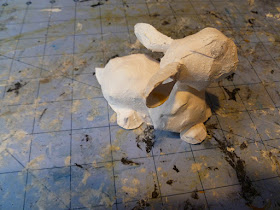 |
| Keep position of details clear for next layer |
You can find part two here.
You can visit me on Facebook.


No comments:
Post a Comment